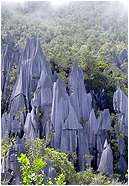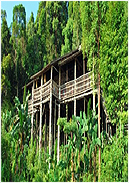Sabah | Sarawak | Brunei
Mulu Caves National Park
 Gunung Mulu National Park is one of Nature's most spectacular achievements and the 'jewel in the crown' of Sarawak's expanding network of national parks. It is also the largest national park, covering 52,865 hectares of primary rainforest, which is criss-crossed by fast flowing rivers and clear jungle streams.
Gunung Mulu National Park is one of Nature's most spectacular achievements and the 'jewel in the crown' of Sarawak's expanding network of national parks. It is also the largest national park, covering 52,865 hectares of primary rainforest, which is criss-crossed by fast flowing rivers and clear jungle streams.
Mulu is dominated by three mountains - Gunung Mulu (2,376 m), Gunung Api (1,750 m) and Gunung Benarat (1,585 m). Yet many of Mulu's greatest attractions lie deep below the surface. Hidden underneath the forested slopes of these mountains is one of the largest limestone cave systems in the world.
This system, a breath-taking natural wonder, contains a number of record breaking caves. With the world's largest cave passage (Deer Cave), the world's largest natural chamber (Sarawak Chamber), and the longest cave in Southeast Asia (Clearwater Cave), it is not surprising that Mulu is now world-famous. Over 200 km of cave passages have been surveyed but this is thought to represent just 30-40% of the actual total.
The oldest of Mulu's caves started to form about 5 million years ago when sideways earth movements resulted in the formation of both limestone and sandstone mountains, lying side by side.
Millions of years of heavy rain and the action of rivers and running water carved out the vast subterranean system that exists today. The weathering process still continues; dripping water creates new rock features, limestone is slowly worn away, and underground rivers carve and sculpt the caves, transporting limestone debris to the cave mouth or redistributing it within the system.
Although Mulu is synonymous with caves, the 'Mulu experience' is not limited to underground attractions; above ground there is plenty to see and do. The park is covered in rich primary rainforest and offers a whole range of nature-based activities. There are some excellent jungle treks and mountain hikes, including the challenging trek to view the Pinnacles - 45 metre high, razor sharp limestone spikes that sit majestically on the slopes of Gunung Api.
With it's rich bio-diversity, and world-famous caves, Mulu offers the adventurous traveller an exhilarating cave and rainforest experience, possibly unmatched anywhere else on Earth.
Mulu's four Show Caves were selected for their uniqueness or sheer beauty. They can all be visited as day trips from the park HQ and are accessible by plankwalks and well-lit concrete paths. Strategically positioned spotlights highlight the unique features of the individual caves. A plankwalk leads through the forest to Deer and Lang's Cave whilst Clearwater Cave and Wind Cave are reached by taking a longboat up the Melinau River, or by following a 4 km nature trail. The more adventurous can do Adventure Caving.
Longhouse
 In Sarawak, the dominant tribal groups are the Dayak. Tribal people live in longhouses. There are the Iban (Sea Dayak), and the Bidayuh (Land Dayak). All of Malaysia’s tribal people feel a strong spiritual connection to the rainforest. The Iban grow rice and fruit, and hunt and fish.
The longhouse is the very centre of communal life in Sarawak. There are over 4,500 longhouses in Sarawak.
In Sarawak, the dominant tribal groups are the Dayak. Tribal people live in longhouses. There are the Iban (Sea Dayak), and the Bidayuh (Land Dayak). All of Malaysia’s tribal people feel a strong spiritual connection to the rainforest. The Iban grow rice and fruit, and hunt and fish.
The longhouse is the very centre of communal life in Sarawak. There are over 4,500 longhouses in Sarawak.
These communal houses, built on stilts, may contain up to 100 individual families in separate 'apartments' built under one long roof.
The rainforest is home to 27 ethnic groups each with own distinct language and culture.
The real longhouse experience begins with the journey upriver. River travel in a perahu - a shallow draught canoe - affords you the pleasure of seeing Sarawak at its best.
Longhouses differ slightly from tribe to tribe but share the same basic characteristic.
The Iban are the largest tribe in Sarawak and one of three native peoples whose past includes the practice of headhunting. Heading upstream, your boatman will take you along idyllic waterways with white pebble beaches, under the over-arching branches of tropical hardwoods, whose dense emerald foliage allows through only a dappling of sunlight.
As you meander upstream, and your boatman punts through the river's shallows, kingfishers glide past, hornbills fly overhead, and local children dive from the riverbank into the cooling waters.
Longhouse inhabitants are very well known for their hospitality. It is normal for people to just turn up and expect to be invited in by the headman (gifts are expected in return). As you arrive at the longhouse, it is customary to be greeted by the longhouse maidens and young men performing traditional dances and playing ceremonial gongs.
At the entrance to the longhouse there is a wooden arch with small baskets made of palm leaves hanging from the top. Offerings such as a few coins or a cigarette are occasionally put into the baskets and help keep evil spirits out of the longhouse.
From the moment you step inside the longhouse you will be treated as an honoured guest. Visitors will be offered a glass of tuak - the very palatable local rice wine. Or more often than not, several glasses of tuak will be offered to wash down a banquet of local delicacies. Then your hosts will start beating the gongs. This is the cue for the traditional dance, usually the Ngajat. The inspiration for the graceful movements of the dancers comes from the effortless flight of the hornbill, Sarawak's emblem. Then your newfound friends will enthral you with stories of Sarawak's legendary past. Usually a longhouse party lasts all night. As the sun is eclipsed by the moon, weary from your day's travel, and a night of dancing and feasting, retire to the ruai- a covered verandah - for a good night's sleep.